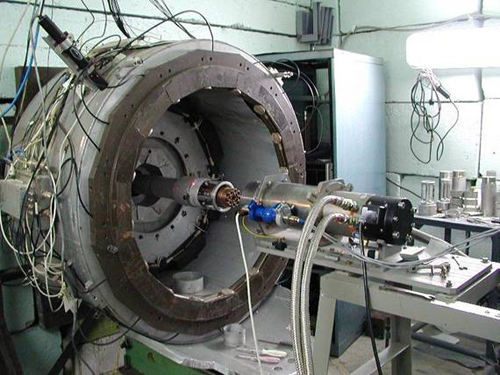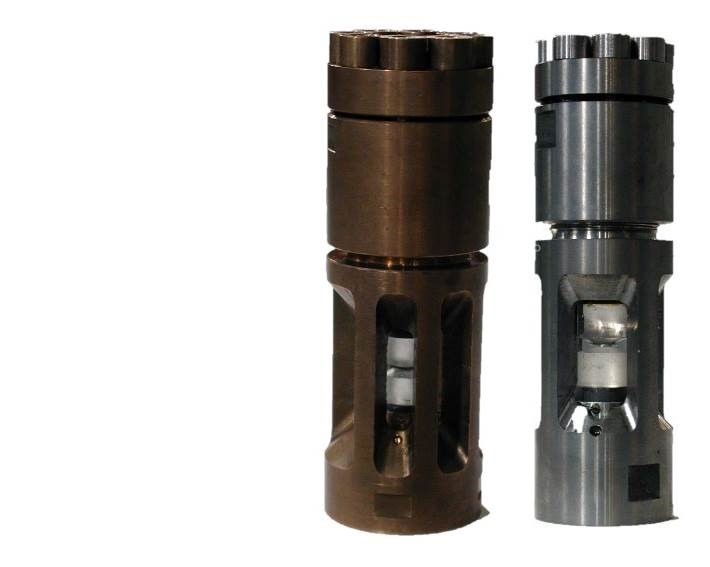Neutron Diffractometer for Investigations of Micro-Samples at High Pressure

DN-12 spectrometer for investigation of micro-samples

The high-pressure cells with sapphire anvils used on DN-12 diffractometer
Instrument Responsible:
Zel Ivan Yurievich
tel.+7 (49621) 6-49-69
e-mail: This email address is being protected from spambots. You need JavaScript enabled to view it.
Main research fields:
1. The crystal structure of condensed matter under high pressure;
2. The magnetic structure of magnetic materials under high pressure;
3. The dynamics of atoms under high pressure (NH4I, NH4Cl, NH4Br);
4. Investigations of small-volume samples by neutron diffraction in a wide temperature range.
Description of the technique
Neutron diffraction technique is a reliable experimental method for obtaining data on the structure and dynamics of a crystal lattice of solids under the action of such external factors as pressure and temperature. A wide range of scientific problems encompassing magnetic phase transitions, structural phase transitions and atomic dynamics are investigated using the neutron scattering technique.
Until recently the application of neutron methods has been restricted to the pressure interval up to 1-2 GPa, because of the use of relatively large samples in cells of the cylinder-piston type.
The development of the method of neutron investigations at high pressures employing the technique of sapphire/diamond anvils in combination with low-background neutron diffractometry has allowed us to extend the pressure range of the experiments to several tens of GPa.
The main parameters
| 1. Flux at sample position (average thermal power of the IBR-2 reactor 2 MW) |
2·106 n/см2/с |
| 2. Distance: moderator-sample sample-detector |
26.0 m 0.4 and 0.6 m |
| 3. Ranges: wavelengths scattering angles |
0.8 – 10 Å 45° – 135° |
| d-spacing/span> | 0.6 – 13 Å |
| 4. Resolution (Δd/d , d = 2 Å): at 2θ = 90° at 2θ = 135° |
0.022 0.012 |
| 5. Solid angle of detector system | 0.125 sr |
| 6. Typical sample volume | 0.5 – 3 mm3 |
| 7. Pressure range with sapphire anvils with diamond anvils |
5 – 10 GPa 7 – 15 GPa |
| 8. Temperature range | 10 – 300 К |
Main research topics
1. Crystal structure of condensed matter under high pressures:
- Crystal structure of molecular crystals (NH4I, NH4Cl, NH4Br, C5H5HReO4, C5H5HNO3, etc.)
- Crystal structure of semiconductors (HgSeS, HgTeS systems)
- Crystal structure of high-temperature superconductors (HgBa2CuO4, HgBa2CaCu2O6.3, SrCaCuO2 and LaCaCuO2 systems)
2. Magnetic structure of magnets under high pressures:
- Changes in magnetic structure of manganites under high pressures (LaCaMnO3, PrBaMnO3, PrCaMnO3 systems, etc.)
- Spin-reorientational phase transitions under high pressures (Fe2O3, FeBO3, MnAs, etc.)
- Frustrated magnets under high pressures (YMnO3 and LuMnO3)
3. Dynamics of atoms under high pressures (NH4I, NH4Cl, NH4Br, etc.)
Auxiliary devices used at the DN-12 spectrometer:
- Cryostat on the basis of closed-cycle helium refrigerator makes it possible to carry out neutron diffraction experiments in a temperature range of 10 - 290 K.
- High-pressure cells based on the technology of sapphire and diamond anvils allow us to conduct neutron diffraction experiments at high pressures up to 10 GPa.
- Cooled beryllium filter permits measurements of inelastic incoherent neutron scattering, which is necessary for investigations of the dynamics of atoms in crystals.
Publications
1. Sergey V. Ovsyannikov, Maxim Bykov, Elena Bykova, Denis P. Kozlenko, Alexander A. Tsirlin, Alexander E. Karkin, Vladimir V. Shchennikov, Sergey E. Kichanov, Huiyang Gou, Artem M. Abakumov, Ricardo Egoavil, Johan Verbeeck, Catherine McCammon, Vadim Dyadkin, Dmitry Chernyshov, Sander van Smaalen, Leonid S. Dubrovinsky, “Charge-ordering transition in iron oxide Fe4O5 involving competing dimer and trimer formation”, Nature chemistry, 8, 5, 501-508 (2016)
2. D. P. Kozlenko, E. Burzo, P. Vlaic, S. E. Kichanov, A. V. Rutkauskas & B. N. Savenko “Collapse in ErCo2:Beyond the Limits of Itinerant Electron Metamagnetism” Sci. Rep. 5, 8620 (2015)
3. D. P. Kozlenko, N. T. Dang, S. E. Kichanov, E. V. Lukin, A.M. Pashayev, S. G. Jabarov, L. S. Dubrovinsky, H.-P.Liermann, W. Morgenroth, A. I. Mammadov, R.Z.Mekhtieva, V.G. Smotrakov and B. N. Savenko “Competing magnetic states and structural modifications in multiferroic YMn2O5 at high pressure” PHYSICAL REVIEW B 92, 134409 (2015)
4. N.M. Belozerova, S.E. Kichanov, Z. Jirak, D.P. Kozlenko, M. Kacenka, O. Kaman, E.V. Lukin, B.N. Savenko “High pressure effects on the crystal and magnetic structure of nanostructured manganites La0.63Sr0.37MnO3 and La0.72Sr0.28MnO3”, Journal of Alloys and Compounds, 646, 998-1003 (2015)
5. Kozlenko D. P., Kichanov S. E., Lukin E. V., Dang N. T., Dubrovinsky L. S., Liermann H.-P., Morgenroth W., Kamynin A. A., Gridnev S. A., and Savenko B. N. “Pressure-induced polar phases in relaxor multiferroic PbFe0.5Nb0.5O3” Physical Review B, 2014, v.89, p.174107.


